|
M o s k v a - E x p r e s s
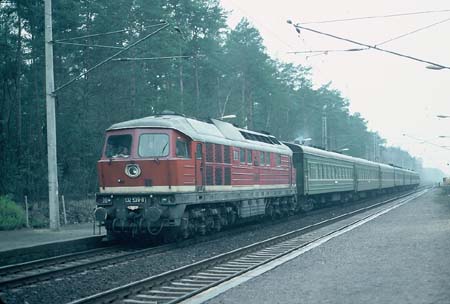
Soviet military express Magdeburg - Brest, German 132 539 from Soviet production, with Soviet "hard" sleepers, near Berlin, April 1991 (WS)
|
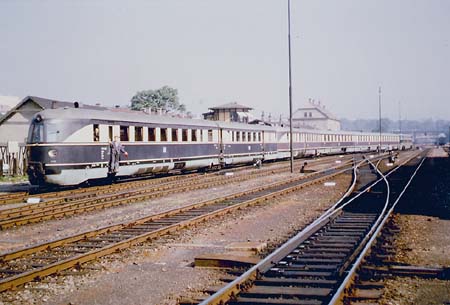
German railcar type "Hamburg" and type "Koeln", the latter being used for "Berolina" services Berlin - Brest, here "Vindobona" for Berlin, hauled by OeBB diesel 2050.01 at Vienna FJB, July 11, 1977 (Ernst Wolf)
|
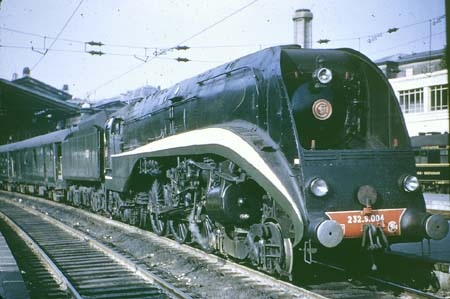
French Hudson 232.S.004, together with the other 232s used for hauling the Nord-Express and the Paris-Scandinavie-Express, at Paris Nord (coll. Heribert Schroepfer)
|
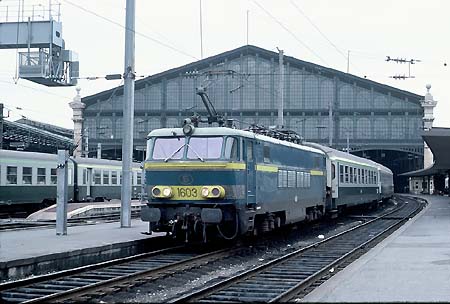
Nord-Express Paris - Copenhagen, Belgian engine 1603, Paris Nord 1984 (WS)
|
The modern Russian passenger cars 0-T on the night trains with sleeping accommodation for everybody since 1948 came mainly from East German production. In 1950 Poland delivered a lower "21.4 type". Then the 01-T variant with a profile suitable for Central Europe appeared. Those cars and later also the higher 0-T, all painted light-green, did now run to the Soviet satellite states, with bogie exchange at the borders.
In 1954 the military express Berlin - Brest was replaced by the first Soviet army through train Berlin - Moscow and in the following years a network of those trains with the 0-T cars of SZD was built up. The timetable e.g. for 1990/91 showed a train from Wuensdorf, the Soviet headquarters in Germany, via Berlin to Moscow with cars also from Schwerin, another train Wuensdorf - Moscow direct, one from Erfurt to Brest and one from Magdeburg and Dresden to Brest. The last Russian military train left Wuensdorf on September 8, 1994.
D 1191
Military express Wuensdorf - Berlin Hbf - Moscow, departure Wuensdorf, April 5, 1991:
1 Mest 57/81, 3 Mest36, 1 Mest 18, 5 Mest 36, 1 Mest 57/81, 1 Pochtovyi (postal van), all cars RZD.
Mest 57/81=open couchette, Mest 36=sleeper 4-berth, Mest 18=sleeper 2-berth (no upper berths). Colors: light-green.
The light-green Soviet cars with their cozy white curtains behind the windows appeared in 1955 at Berlin Ostbahnhof also for civilians. It was the D102/101, the new all-sleeper train Berlin - Moscow. From 1959 the railcar "Berolina" Berlin - Brest offered an additional faster connection, then it was confined to Warsaw. The violet/cream pre-war VT137 type "Koeln" and sometimes the VT12.14, built in Hungary, were used. Already in 1955 the Soviets proposed a sleeper to Paris, in 1960 East German DR repeated the proposal, but French SNCF hesitated on account of their contract with CIWL. These administrations however refused the Soviets' offer to run CIWL sleepers to Moscow! Finally, under political pressure presumably by French government, they had to accept the Soviet sleepers, a new RIC type, running from 1960 to Paris and to Hoek, combined with the Scandinavia-Paris- and the Nord-West-Express. Though in 1961 the Soviets ordered to build the Berlin wall, sleepers from Moscow to Oostende, Copenhagen, Hamburg and Bern appeared later. In 1969 this train got its adequate name "Ost-West-Express". The Paris - Moscow sleeper temporarily was conveyed by the Nord-Express. The group was so complicated, that in 1985 the big shunting had to be centralized at one station, Rzepin, just behind the new Polish border.
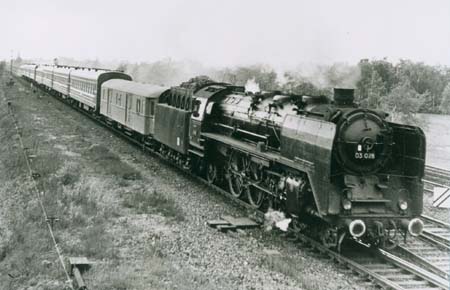
Moskva-Express Berlin - Moscow with German 03 028, Polish van, Soviet sleepers, no.5 being a different Soviet RIC type, and in the rear a DR pre-war diner, in 1964/65 (DR archives, coll. Rico Bogula)
|
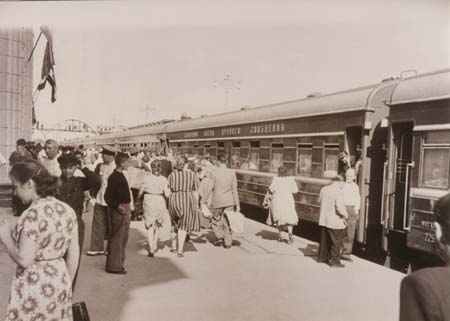
Special for East German tourists, consisting of Soviet sleepers and diners, offering tours to Minsk, Moscow and Leningrad, started in 1957 (Weiss, DR archives)
|
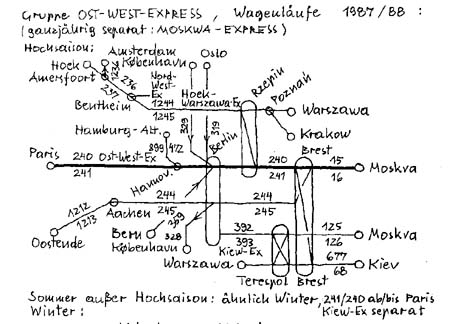
Ost-West-Express during high season 1987 (WS)
|
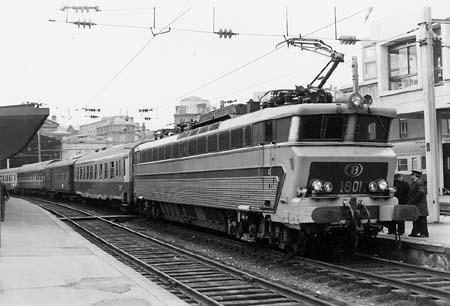
Nord-Express, Belgian 1801 (French type CC40000), French cars and Soviet sleeper Paris - Moscow, Paris Nord, February 1980 (WS)
|
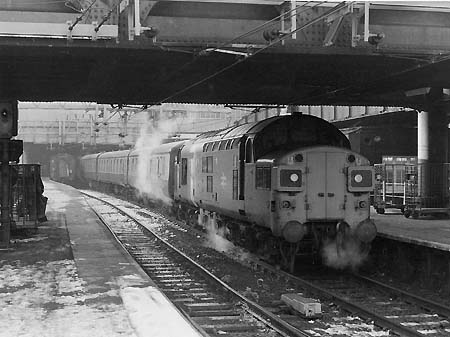
Day Continental boat train London - Harwich Parkeston Quay, connecting with the Nord-West-Express for Eastern Europe, BR diesel 37 023, London Liverpool Street, Jan. 1979 (WS)
|
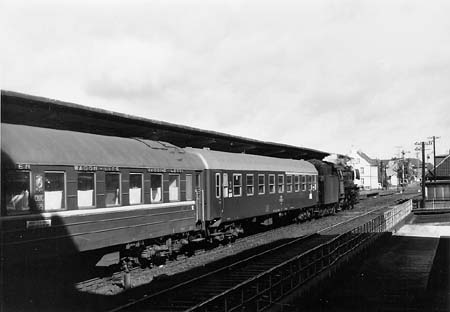
The late-running Moscow portion of the Nord-West-Express, consisting of a Polish car from Warsaw and the RIC type Soviet sleeper Moscow - Hoek, exceptionally steam-hauled by a DB class 042, at Rheine, May 16, 1969 (WS)
|
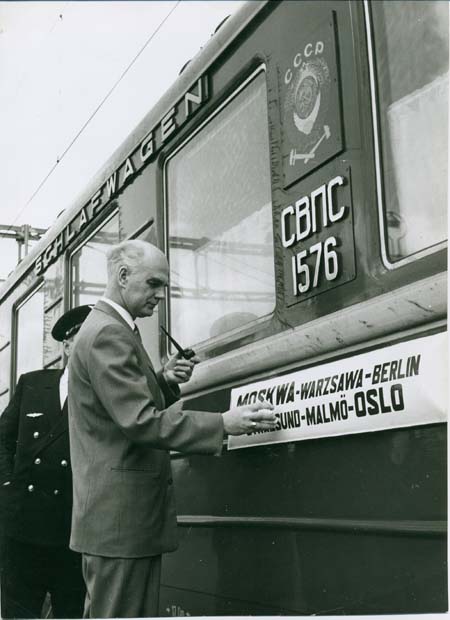
Arrival of the Soviet sleeper at Oslo (NSB official photo)
|
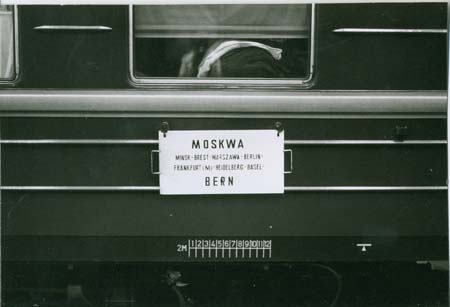
Soviet sleeper to Bern, temporarily extended to Madrid (WS)
|
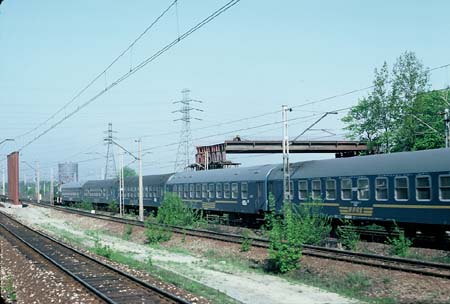
Polones, the Polish all-sleeper train Moscow - Warsaw, approaching Warsaw in May 1986 (WS)
|
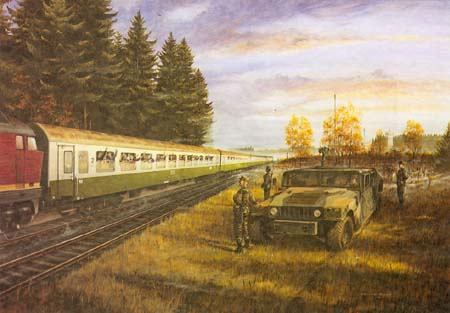
DR special with refugees escaping from communist East Germany via Czechia, arriving near Hof in Oct. 1989, painted by George Finley (U.S. Second Armored Cavalry Regiment/ coll. Christoph Baron von Zeschau)
|
In 1960 the exclusive Berlin - Moscow D102 had become the “Moskva-Express”, from 1965 with sleepers Oslo - and Stockholm - Moscow. In 1990 finally came the sleeper Moscow - Madrid, running via Geneva and Hendaye. In 1972 the Leningrad-Express started at Berlin and from 1975 the blue Polish “Polones” did run from Warsaw to Moscow.
With the end of the Soviet Union in 1992 the decline of those trains had come. In communist time, the sleeping cars had been heavily subsidized, e.g. with a ticket price of c.60 dollar for Budapest - Beijing. The Russian proposal of a “high-comfort” express in 1989 led only to a Cologne - Moscow train without diner. In 1993/94 Waggonbau Goerlitz completed 100 sleepers of the new WLABmee type, ordered by the Soviets, but Russia couldn’t pay and 20 cars were bought by Belarus, Ukraina, Lithuania and Slovakia. The red/blue Russian and the turquoise Belarus cars appeared on the Ost-West-Express, but in 1994 this train was confined to Brussels - Moscow and in 1998 the label disappeared. It was replaced by a train with the unknown name Jan Kiepura, in 2004 equipped with comfortable white/dark-blue Polish sleepers, couchettes, a “sleeperette” and a dining-car, red/blue Russian and light-blue Belarussian sleepers. From 2006 it ran to Frankfurt (M) via Cologne, and no longer to Brussels. In late 2007 a Russian sleeper Munich – Moscow (via Hannover with the night train Innsbruck - Munich – Copenhagen) and a Russian sleeper Basle – Moscow were added to the Jan Kiepura, running Amsterdam – Moscow. At Hannover the cars from Amsterdam, Basle and Munich to Copenhagen were combined to a night train to be ferried via Puttgarden - Rodby, while the cars for Moscow were added to the Jan Kiepura. In Russia it preserved its traditional name Vostov-Zapad Ekspress, what means Ost-West-Express. For travelers from Munich only to Poland it was not allowed to take the Russian sleeper, it was watched running empty and in December 2010 it disappeared.
The Moskva-Express with a different timing continued running Berlin - Moscow with blue/red, sometimes also light-blue/white Russian sleeping cars, from 2004 including a refurbished de-luxe sleeper with a cozy “Russian” bar and from 2006 a short-term once-weekly Russian sleeper from Berlin to Kazan in the autonomous Tatarstan region. In 2008 even a Russian sleeper Paris Est (!) – Moscow appeared. The Russian sleeper Berlin – St. Petersburg disappeared in 2011.
Europe’s most exotic train had started in 1993. It was the once-weekly D1249 Berlin - Saratov, with cars to Astana (at that time Akmola) in Kazakhstan and from 1997 to Novosibirsk. It became the train for the Germans living in Russia - “der Zug der Wolga-Deutschen” - and the train of the traders. It ran alternating with a Warsaw - Simferopol and Tashkent special and from 2001 in the timetable of the Moskva-Express, on an alternate day however, avoiding Moscow.. Occasionally it arrived at Berlin with cars even from Vladivostok, but the cars to Astana were temporarily abandoned. From December 2008 it was combined between Berlin and Warsaw with the Kashtan Express to Kiev.
Cook’s timetable, edition January 2009, listed the departure of the combined trains from Berlin Hauptbahnhof at 15:15 as follows:
Monday:
Kashtan Express Berlin – Kiev - Odessa
Tuesday:
Kashtan Express Berlin – Kiev - Simferopol
Wednesday:
Kashtan Express Berlin – Kiev – Odessa
Moskva Express Berlin – Moscow, Paris Est – Berlin – Moscow, Berlin – Orsha – St. Petersburg
Thursday:
Kashtan Express Berlin – Kiev – Kharkov
Friday:
Kashtan Express Berlin – Kiev – Simferopol, Berlin – Kiev – Odessa
Moskva Express Berlin – Moscow, Berlin – Orsha – St. Petersburg
Saturday:
Kashtan Express Berlin – Kiev, Berlin - Lvov
Saratov Express Berlin – Smolensk - Michurinsk – Saratov, Berlin – Michurinsk – Rostov, Berlin – Perm – Omsk – Novosibirsk
Sunday:
Kashtan Express Berlin – Kiev – Kharkov
Moskva Express Berlin – Moscow, Paris Est – Berlin – Moscow, Berlin – Orsha – St. Petersburg
The Kashtan-Express main portion consisted of 3 cars Berlin – Kiev, the Saratov-Express main portion of 3 cars Berlin – Saratov, departing in summer also on Monday. The other connections of the Saratov-Express comprised one car each. The cars are 4-berth sleepers. The Moskva-Express was different, comprising also a Berlin – Moscow “Lux”, a Paris – Moscow sleeper 1st 2nd class and a diner Brest – Moscow. According to Rico Bogula, the Saratov-Express comprised also one car each Berlin - Rostov – Adler (on the Black Sea), Berlin – Ryazan – Ufa, Berlin – Ufa – Astana (re-introduced), Berlin – Chelyabinsk and Berlin – Omsk.
D102/7102/4
Departure Berlin Ost, Easter 1960 (according to M. Lepple):
| 1 Pochtovyi | SZD | Berlin - Moscow |
| 2 Mest 36 | SZD | Berlin - Moscow |
| 2 Mest 32 | SZD | Berlin - Moscow |
| 1 Mest 36 | SZD | Berlin - Moscow |
| 1 Mest 32 | SZD | Berlin - Moscow |
| 1 Bagazhnyi | SZD | Berlin - Moscow |
At Brest 1 Mest 32 Prague/Vienna - Moscow, 1 Mest 32 Warsaw - Moscow, 1 Restoran and 2 other 0-T cars were added.
Traction: 03 (4-6-2) Berlin - Frankfurt (0), surely Pt 47 (2-8-2) in Poland, Terespol - Brest Ty2 (ex-German 52), from Brest P36 (4-8-4), from Mozhaisk d.c. VL19 or VL22m. In Germany temporarily also the 6510 (2-8-4T) was used. In Russia from 1964 twin-diesels TE7 or TE3, later 2TEP60, replaced steam.
Vostok-Zapad (Ost-West-Express)
Moscow Belorusski, March 28, 1988:
| ChS7 (3kVd.c.) | SZD | Vyazma - Moscow |
| 5 Mest 38 | SZD | Brest - Moscow |
| 1 Restoran | SZD | Brest - Moscow |
| 4 Mest 36 | SZD | Berlin - Moscow |
| 1 WL RIC | SZD | Berlin - Moscow |
| 1 Mest 36 | SZD | Berlin - Moscow |
| 1 WL RIC | SZD | Oostende - Moscow |
| 1 WL RIC | SZD | Bern - Moscow |
| 1 WL RIC | SZD | Paris - Moscow |
On alternate days WL RIC SZD from Oslo/ Copenhagen /Hoek /Hamburg /Geneva.
Colors: light green.
Traction: 110(15kV) on DB; 132 (diesel) on DR; SP45 (diesel) and EU07 (3kV d.c.) on PKP, ChS4 (25kV) and Ch S7 (3kV d.c.) on SZD.
D 1249
Berlin Lichtenberg - Smolensk - Ryazan - Michurinsk - Saratov, once weekly, departure Berlin, June 17, 1995
| 155 162 (CoCo 15kV, DB) Berlin - Frankfurt (O) | |
| 143 145 (BoBo 15kV, DB, exceptionally) | |
| 2 Mest 36 | KZ | Berlin - Saratov - Uralsk - Akmola (Astana) |
| 2 Mest 36 | RZD | Berlin - Saratov |
| 1 Mest 18 | RZD | Berlin - Saratov |
| 3 Mest 36 | RZD | Berlin - Saratov |
| 1 Mest 36 | RZD | Berlin - Saratov - Samara - Omsk |
| 1 Mest 36 | RZD | Berlin - Michurinsk - Rostov |
| 1 Mest 36 | RZD | Berlin - Michurinsk - Voronezh |
At Warsaw Mest 36 and at Brest a restarurant and more cars were added.
Colors: DB locomotives red, cars RZD light-green, KZ (=Kazkhstan) light-blue.
Later there were cars to Astana, Novosibirsk, Omsk, Yekatarinburg, occasionally Vladivostok, and to Rostov, Ufa, Voronezh, Saratov. From Dec. 2003 the train consisted of a red/blue RZD RIC sleeper Berlin - Astana and RZD’s light-blue/white modernized RIC sleepers to Saratov, Yekatarinburg, Omsk, Novosibirsk, Rostov and Voronezh, in Germany hauled by 232 or 233 series diesels or electrics. From 2004 the cars to Astana in Kazakhstan ran from Warsaw only on alternate days. From December 2007 cars Berlin - Astana, alternatively Irkutsk, should run. This once-weekly train was named Sibirjak, destinations of the various train sections were St.Petersburg, Moscow, Novosibirsk, Kazan, Chelyabinsk, Ufa, Astana (in Kazakhstan) and Adler (near Sochi), divided at Minsk (see wikipedia.org/ wiki/ Sibirjak). This most exotic train of Europe was discontinued from Dec14, 2013.
Moskva-Express
Berlin - Warsaw - Moscow, departure Berlin, March 30, 2004 (according to Rico Bogula):
| 101 (BoBo 15kV ac) | DB | Berlin - Frankfurt (O) |
| 3 WLAB (RIC sleeper) | BC | ...Berlin - Minsk |
| 1 WLAB (RIC sleeper) | RZD | Berlin - St.Petersburg |
| 4 WLABmee (new sleeper) | RZD | Berlin - Moscow |
Colors: BC (=Belarus) light-blue, RZD red/blue.
Berlin - Warsaw - Moscow, departure Berlin, Oct.18, 2006 (according to Rico Bogula):
| 115 (BoBo 15kV ac) | DB | Berlin - Frankfurt (O) |
| 1 WLAB (RIC Sleeper) | RZD | Berlin - Kazan |
| 3 WLAB (RIC Sleeper) | BC | Berlin - Minsk |
| 1 WLAB (RIC Sleeper) | RZD | Berlin - St. Petersburg |
| 4 WLABmee (sleeper) | RZD | Berlin - Moscow |
Colors: BC (=Belarus) light-blue, RZD red/blue.
Ian Kiepura
Departure Amsterdam (thrice weekly with sleeper to Minsk), Jan.27, 2013::
| 1740 | NS | Amsterdam - |
| 1 WLAB (sleeper) | DB | Amsterdam - Copenhagen |
| 2 Bc (couchette) | DB | Amsterdam - Copenhagen |
| 1 WLAB (sleeper) | PKP | Amsterdam – Warsaw |
| 1 Bc (couchette) | DB | Amsterdam - Warsaw |
| 1 B (sleeperette) | PKP | Amsterdam - Warsaw |
| 1 WLAB (sleeper) | CD | Amsterdam - Prague |
| 1 Bc (couchette) | DB | Amsterdam - Prague |
| 1 B (2nd class) | DB | Amsterdam - Prague |
Colors: NS French type BoBo electric engine yellow/blue, cars DB whitish/red, PKP whitish/blue, WL CD blue.
Special literature:
Rico Bogula: Internationale Schnellzuege in der DDR, EK Verlag, Freiburg
Moscow – Paris and Innovations
For 12 December 2011 a sensation was announced: A Russian all-sleeper express Moscow – Berlin – Frankfurt - Mannheim – Paris departed from Moscow on Monday at 6:30 and arrived the other day after 36 ½ hours traveling time at 20:31 in Paris, consisting exclusively of Russian sleepers. Russian diners between Moscow and Brest and Polish between Warsaw and Paris provided service. The fares mentioned were 330 euro for a place in a 3-berth compartment and 1,050 euro for de-luxe in a cabin with own toilet and shower. Three departures every week, during season 5 weekly departures were announced. The Federal Passenger Co., a subsidiary of Russian Railways RZhD, is the operator, in cooperation with Rail Europe, the SNCF and the other railways. The official Web site described the train consisting of 2 RIC type de-luxe cars, 1 restaurant and 6 other RIC type sleeping-cars (for the similar train Moscow – Vienna – Nice see the chapter Eastern Europe).
New RIC type sleeping-cars were introduced in 2014, built in cooperation with Siemens.
Another sensation in 2011 was the contract of Russia with Talgo of Spain for delivery of three RD type sleeping-car trains, consisting of 20 cars each, with automatic gauge-change for shortening the travelling-time Moscow – Berlin from 25 to 18 hours. Four other Talgo trains were ordered for Moscow – Kiev, but with the political troubles they were used otherwise. Moscow – Berlin should have been started in December 2015, but Schweizer Eisenbahn-Revue 2/2015 shocked with the headline: “DB interdicts test trials with the RZD Talgo.” The magazine reported the German DB Netz AG’s concerns about safety when crossing bridges. But since decades Talgo trains were running in many European countries, including Germany, without falling from any bridge. Then tests were carried out in EU-country Austria for opening service in 2016. Introduction of the Russian Talgo Moscow – Berlin under the label Swift in December 2016 was started, but in January 2017 an official DB ticket office informed only about a once-weekly train from Berlin to Moscow with conventional timing.
For European standard gauge, Poland ordered from Alstom electric Pendolino train sets, non-tilting. They were introduced in Dec 2014 on domestic services from Warsaw to Gdynia and to Krakow.
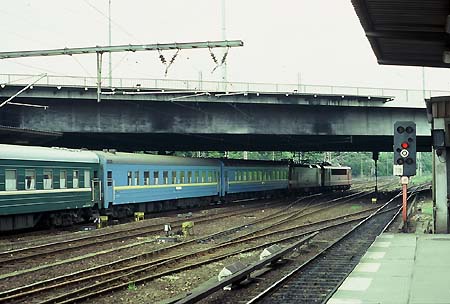
D1249 Berlin - Saratov (- Akmola/ Omsk/ Rostov), DB (ex-DR) locomotives 155 162 and 143 145 with two blue Kazakh sleepers and green Russian sleepers, departure Berlin Lichtenberg, June 17, 1995 (WS)
|
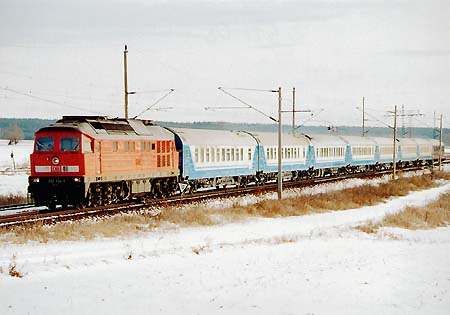
D1248 Saratov - Berlin with DB diesel class 232 (ex-DR) and Russian sleepers from Voronezh, Rostov, Ufa, Omsk, Yekatarinburg, Novosibirsk and Astana, at Pillgram near Frankfurt (O), Jan. 31, 2004 (Rico Bogula)
|
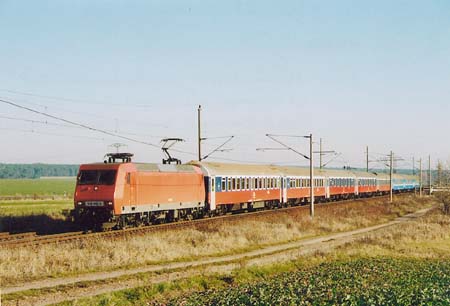
Moskava-Express, German class 145, 4 Russian sleepers Moscow - Berlin, one St. Petersburg - Berlin and 3 Belarus sleepers Minsk - Berlin, approaching Berlin, Nov. 2003 (Rico Bogula)
|
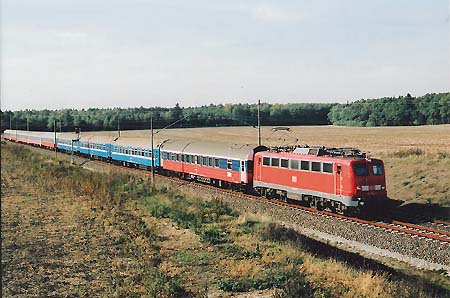
Moskva-Express Berlin - Moscow (- Kazan/ - St.Petersburg) near Frankfurt (O), June 27, 2006 (Rico Bogula)
|
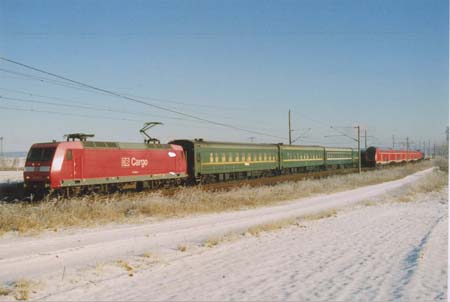
D1248 Saratov - Warsaw - Berlin near Frankfurt/O in Jan. 2003 (Rico Bogula)
|
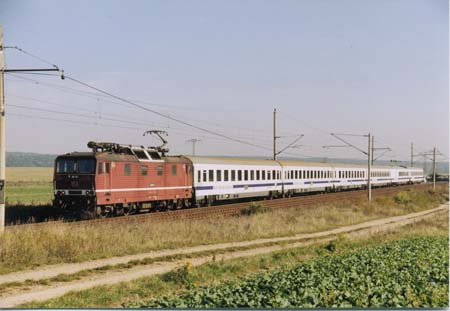
EC46 Berlin-Warszawa-Express near Frankfurt/O in 2003 (Rico Bogula)
|
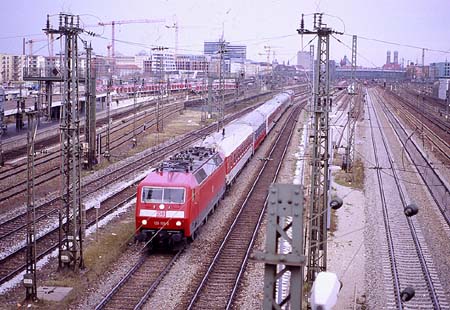 City Night Line 482 with a 120 class engine, a German couchette für Warsaw, a Russian sleeper für Moscow, diner, couchettes and a twin storey sleeper für Copenhagen, after departure at Munich, April 2008 (WS)
City Night Line 482 with a 120 class engine, a German couchette für Warsaw, a Russian sleeper für Moscow, diner, couchettes and a twin storey sleeper für Copenhagen, after departure at Munich, April 2008 (WS)
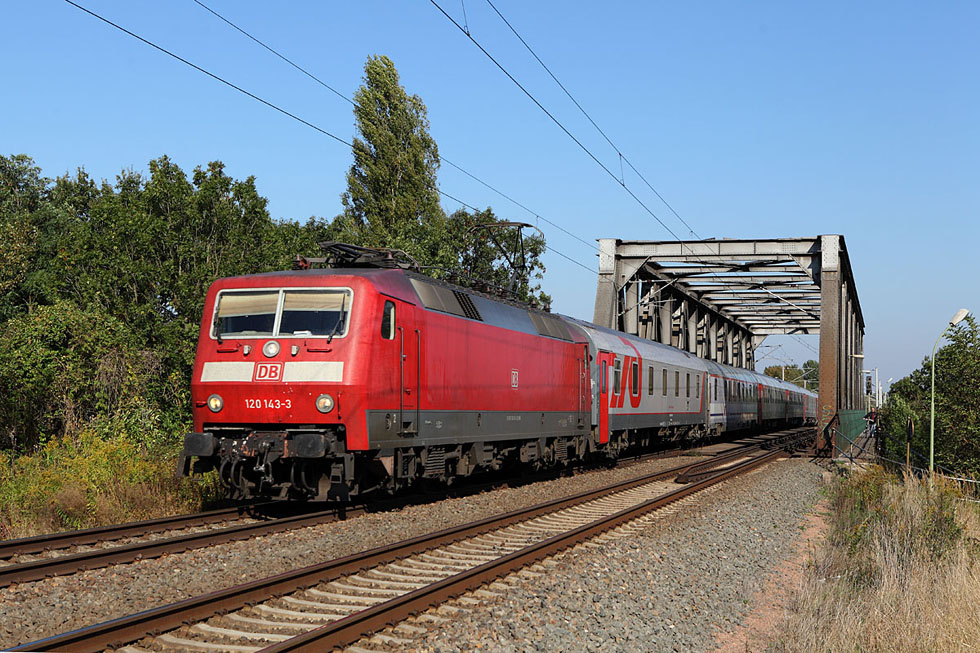
Express Moscow – Paris, introduced in December 2011: EN 452 with class 120 at Schkopau (Daniel Berg, 30.09.2013)
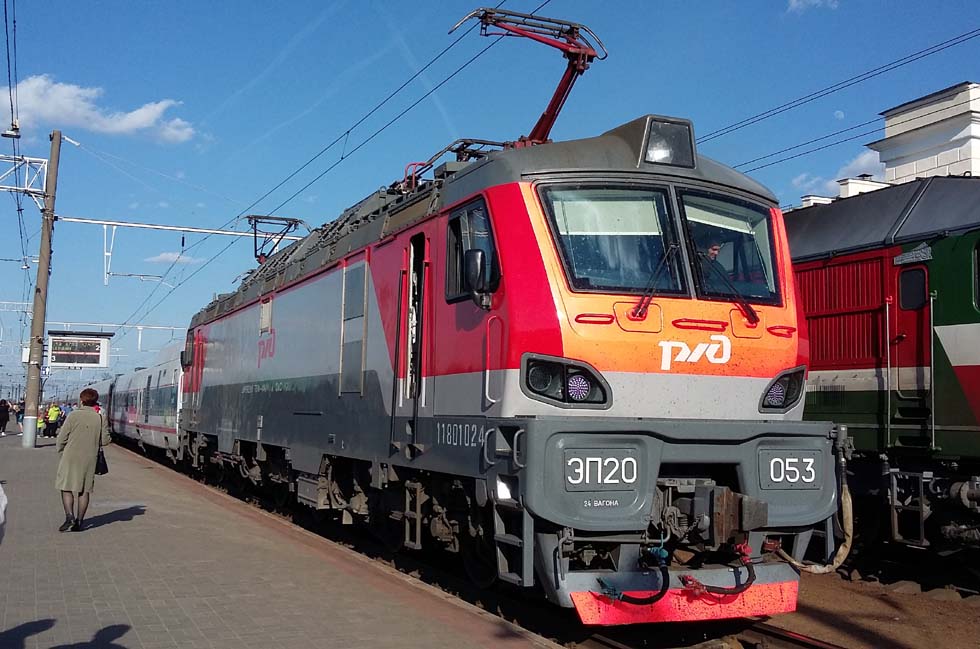
Talgo Moscow – Berlin with RZD-EP20 in Orscha Central. (Sascha Jansen, May 2017)
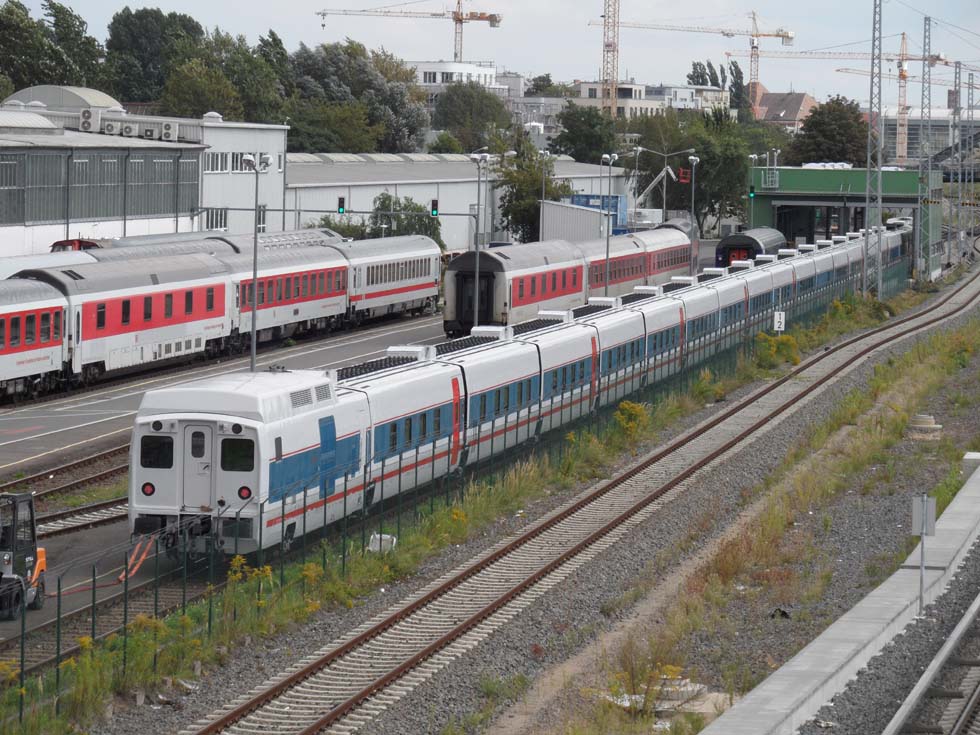
Talgo Moscow – Berlin, introduced in December 2016 parked in Berlin Warschauer Street. (Heiko Mueller, April 2014)
|



























